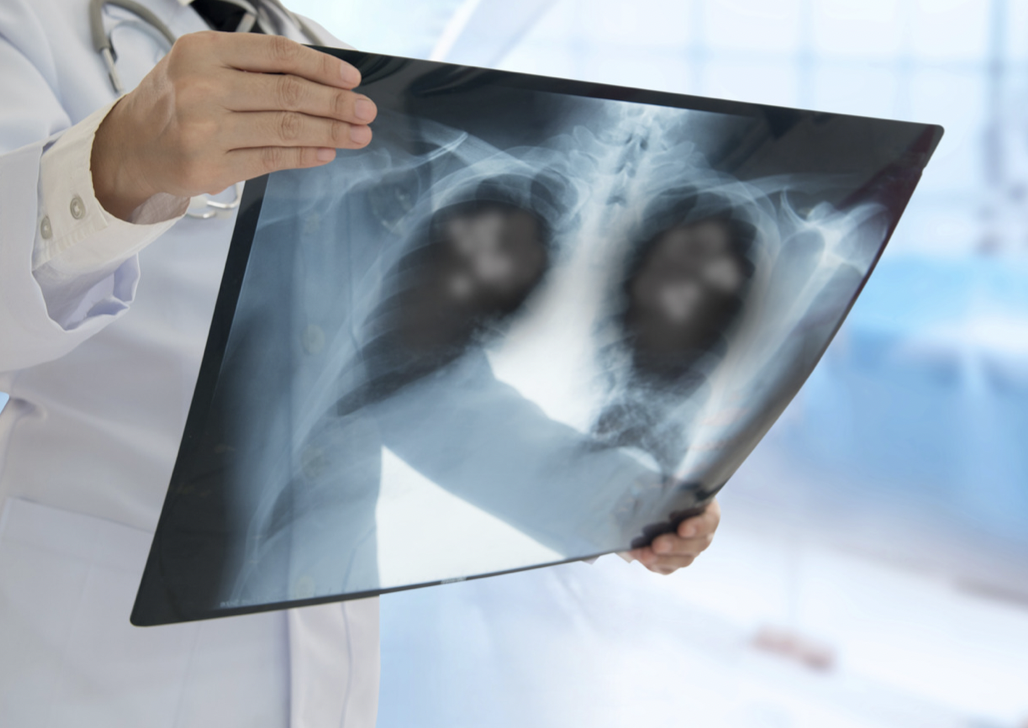Definisi
Pneumonia adalah infeksi pada jaringan paru. Infeksi bisa mengenai alveolus atau kantong udara di paru, maupun mengenai bronkus dan bronkiolus yaitu saluran udara percabangan dari trakea atau tenggorokan.
Pneumonia terjadi ketika virus, bakteri, atau jamur menyebabkan peradangan dan infeksi pada jaringan paru. Pneumonia yang mengenai alveolus dan juga bronkus disebut dengan bronkopneumonia.
Orang dengan bronkopneumonia bisa mengalami kesulitan bernapas karena saluran udaranya menyempit serta adanya peradangan jaringan paru. Peradangan tersebut menyebabkan paru-paru tidak mendapat cukup oksigen.
Penyebab
Bronkopneumonia dapat disebabkan oleh virus, bakteri, atau jamur. Kebanyakan kasus disebabkan oleh bakteri. Kuman bersumber dari penularan antar orang melalui percikan bersin atau batuk.
Bakteri penyebab bronkopneumonia yang paling sering adalah:
- Staphylococcus aureus
- Haemophilus influenzae
- Pseudomonas aeruginosa
- Escherichia coli
- Klebsiella pneumoniae
- Spesies Proteus
Bronkopneumonia juga sering terjadi di lingkungan rumah sakit. Orang sakit memiliki sistem imun tubuh yang lemah sehingga mudah tertular penyakit, termasuk penyakit paru. Pneumonia yang terjadi di rumah sakit mungkin juga disebabkan oleh bakteri yang resisten terhadap antibiotik.
Faktor Risiko
Beberapa faktor yang meningkatkan risiko bronkopneumonia adalah:
- Usia. Orang yang berusia 65 tahun atau lebih dan anak-anak di bawah 2 tahun memiliki risiko lebih tinggi untuk terkena bronkopneumonia dan komplikasinya
- Lingkungan. Orang yang bekerja atau sering mengunjungi rumah sakit atau panti jompo memiliki risiko lebih tinggi terkena bronkopneumonia
- Gaya hidup. Merokok, gizi buruk, dan penggunaan alkohol berat dapat meningkatkan risiko bronkopneumonia
- Kondisi medis. Memiliki penyakit tertentu meningkatkan risiko terkena bronkopneumonia. Kondisi medis tersebut meliputi:
- Penyakit paru-paru kronis seperti asma atau penyakit paru obstruktif kronik (PPOK)
- HIV/AIDS
- Memiliki sistem imun tubuh lemah karena kemoterapi atau penggunaan obat penekan sistem imun
- Penyakit kronis, seperti penyakit jantung atau diabetes
- Penyakit autoimun, seperti rheumatoid arthritis atau lupus
- Kanker
- Batuk kronis
- Kesulitan menelan
- Penggunaan ventilator
Jika Anda termasuk dalam salah satu kelompok risiko di atas, konsultasi dengan dokter mengenai cara mencegah dan mengatasinya.
Gejala
Gejala bronkopneumonia bervariasi dari ringan hingga berat dan umumnya mirip dengan gejala pneumonia lainnya. Keluhan yang dirasakan biasanya dimulai dengan gejala seperti flu yang bisa memberat dalam beberapa hari. Gejala lainnya meliputi:
- Demam
- Batuk berlendir
- Sesak napas
- Nyeri dada
- Pernapasan cepat
- Berkeringat
- Menggigil
- Sakit kepala
- Nyeri otot
- Kelelahan
- Kebingungan atau delirium, terutama pada orang tua
Gejala dapat lebih berat pada orang dengan sistem imun yang lemah atau memiliki penyakit lain.
Gejala pada anak
Anak-anak dan bayi dapat menunjukkan gejala yang berbeda. Meskipun batuk adalah keluhan paling umum pada bayi, mereka juga dapat menunjukan tanda atau gejala:
- Detak jantung yang cepat
- Kadar oksigen darah rendah
- Retraksi atau tarikan otot dada saat bernapas
- Rewel
- Nafsu makan menurun
- Demam
- Sesak
- Sulit tidur
Diagnosis
Hanya dokter yang dapat mendiagnosis bronkopneumonia. Dokter akan menanyakan gejala dan riwayat kesehatan, lalu melakukan pemeriksaan fisik. Dengan menggunakan stetoskop, dokter akan mendengarkan mengi dan suara napas abnormal lainnya.
Jika infeksi paru cukup berat atau paru penuh dengan cairan, suara napas dapat kurang terdengar.
Dokter juga akan melakukan pemeriksaan penunjang untuk menyingkirkan penyakit lain yang dapat menimbulkan gejala yang mirip dengan bronkopneumonia. Penyakit lain tersebut antara lain bronkitis, asma bronkial, atau pneumonia lobar.
Pemeriksaan penunjang yang dapat dilakukan meliputi:
- Rontgen dada. Umumnya akan tampak beberapa area infeksi yang tidak merata, biasanya di kedua paru-paru dan sebagian besar berada di dasar paru.
- Hitung darah lengkap. Jumlah total sel darah putih yang tinggi, dengan jumlah jenis sel darah putih tertentu yang tinggi, dapat menunjukan adanya infeksi bakteri
- Kultur darah atau dahak, untuk menentukan jenis kuman penyebab infeksi
- CT scan, memberikan tampilan jaringan paru yang lebih detail
- Bronkoskopi. Dapat melihat saluran napas lebih dekat sekaligus mengambil sampel jaringan paru sambil memeriksa infeksi dan kondisi bagian paru lainnya
- Oksimetri. Ini adalah tes sederhana untuk mengukur persentase oksigen dalam darah. Semakin rendah angkanya, semakin rendah kadar oksigen dalam tubuh.
Tata laksana
Bronkopneumonia dapat ditangani dengan pengobatan sederhana di rumah ataupun memerlukan perawatan medis oleh dokter.
Perawatan di rumah
Bronkopneumonia karena virus biasanya tidak memerlukan perawatan medis, kecuali jika berat. Umumnya akan membaik dengan sendirinya dalam dua minggu. Jika disebabkan oleh bakteri atau jamur, biasanya memerlukan pengobatan.
Perawatan medis
Dokter akan meresepkan antibiotik jika bronkopneumonia disebabkan oleh bakteri. Kebanyakan orang akan merasa lebih baik dalam tiga sampai lima hari setelah minum antibiotik. Antibiotik harus dihabiskan untuk mencegah kekambuhan infeksi dan resistensi antibiotik.
Pada kasus infeksi virus seperti influenza, dokter dapat meresepkan antivirus untuk mengurangi lamanya penyakit dan tingkat keparahan gejala.
Perawatan di rumah sakit
Perawatan rumah sakit diberikan jika infeksi parah dan pasien memenuhi salah satu kriteria berikut:
- Berusia di atas 65 tahun
- Mengalami kesulitan bernapas
- Mengalami nyeri dada
- Memiliki napas yang cepat
- Memiliki tekanan darah rendah
- Menunjukkan tanda-tanda kebingungan
- Memerlukan bantuan napas
- Menderita penyakit paru kronis
Pengobatan di rumah sakit antara lain pemberian antibiotik dan cairan melalui pembuluh darah atau infus. Jika kadar oksigen rendah, pasien juga memerlukan terapi oksigen.
Dokter akan meresepkan antibiotik jika anak mengalami infeksi bakteri. Obat sesuai keluhan juga akan diberikan untuk mengurangi gejala. Pastikan anak mendapat cukup cairan dan istirahat.
Dokter akan memberikan obat penurun demam. Obat hirup juga dapat diresepkan untuk membantu menjaga saluran udara tetap terbuka. Pada kasus yang parah, anak mungkin memerlukan rawat inap untuk mendapatkan:
- Terapi cairan melalui infus
- Obat-obatan
- Oksigen
- Terapi pernapasan
Selalu tanyakan kepada dokter anak sebelum memberikan obat batuk ke anak. Obat batuk jarang direkomendasikan untuk anak-anak di bawah usia 6 tahun. Penting juga untuk memperhatikan kebersihan anak Anda.
Komplikasi
Komplikasi bronkopneumonia antara lain:
- Sepsis, atau infeksi yang meluas melalui aliran darah
- Abses paru, yaitu penumpukan nanah di paru
- Penumpukan cairan di selaput paru atau efusi pleura
- Gagal napas
- Gagal ginjal
- Gangguan jantung seperti gagal jantung, serangan jantung, dan irama jantung tidak teratur
Pencegahan
Tindakan pencegahan sederhana dapat mengurangi risiko sakit dan terkena bronkopneumonia, contohnya melalui mencuci tangan dengan benar.
Vaksinasi juga dapat mencegah jenis pneumonia tertentu. Pastikan untuk imunisasi influenza setiap tahunnya karena influenza dapat menyebabkan pneumonia. Pneumonia bakteri juga dapat dicegah dengan vaksin pneumokokus. Vaksin ini tersedia untuk orang dewasa dan anak-anak.
Konsultasi dengan dokter untuk menentukan apakah vaksin bermanfaat bagi Anda dan keluarga. Pelajari lebih lanjut tentang jadwal vaksin untuk bayi dan balita.
Kapan harus ke dokter?
Konsultasi ke dokter jika mengalami tanda dan gejala bronkopneumonia di atas. Penanganan segera akan mempercepat penyembuhan dan mencegah komplikasi.
- dr Anita Larasati Priyono
Waseem M. (2020). Pediatric pneumonia. Retrieved 16 February 2022, from https://emedicine.medscape.com/article/967822-overview#a1
Martel J. (2019). Bronchopneumonia: symptoms, risk factors, and treatment. Retrieved 16 February 2022, from https://www.healthline.com/health/bronchopneumonia
Kandola A. (2018). What is bronchopneumonia?. Retrieved 16 February 2022, from https://www.medicalnewstoday.com/articles/323167











